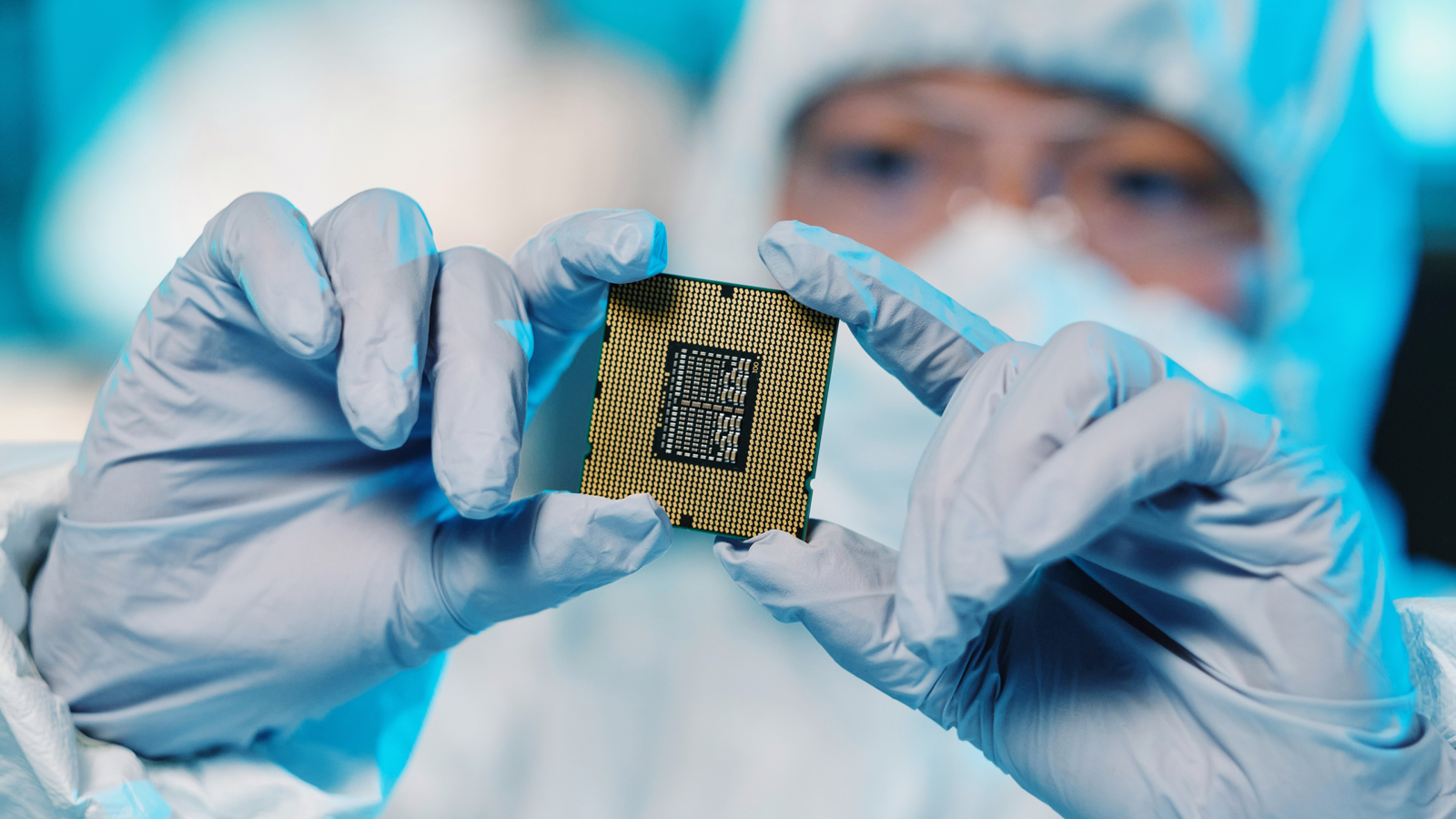Good morning.
Federal Reserve Governor Christopher Waller used the ‘T’ word Monday. He said any sharp price increases caused by tariffs will likely be “transitory,” invoking a term that has haunted Fed Chair Jerome Powell, who was ultimately proven wrong when using it to describe inflation in the early days of the pandemic.
As for why he would dare use the contentious term — which he acknowledged might prompt “howls” — Waller invoked the famed “Tush Push” play that helped the Philadelphia Eagles win the Super Bowl this year: “You call for the Tush Push but fail to convert by running the ball. Since it didn’t work out the way you expected, does that mean that you shouldn’t call for the Tush Push the next time you face a similar situation? I don’t think so.”
Whatever play is called, we’re good so long as there’s no economic “Butt Fumble.”
Intel Takes an L, Pulling Back From Chip Biz Altera

The chips are down, and Intel’s cashing out.
On Monday, Intel said that it plans to sell a majority stake of chip biz Altera to buyout firm Silverlake in a deal that values Altera at about half of what the chipmaker bought it for 10 years ago.
Playing Catch-up
Altera specializes in a type of semiconductor called a field program gate array (FPGA) that’s used in a variety of industries including telecom, defense, and robotics. The market for FPGAs is expected to more than double from last year to 2029. A decade ago, Intel scooped up Altera for nearly $17 billion in a bid to break into the FPGA market (its biggest deal ever), but Altera lost ground to competitors like Advanced Micro Devices (AMD) over time. Last year, Altera’s $1.54 billion in revenue made up just 3% of Intel’s sales, and it notched a $615 million operating loss. Now, Intel’s cutting its losses, selling off 51% of Altera in a deal that values the company at less than $9 billion.
That’s just the way it’s been going for Intel lately, as the stumbling former No. 1 chipmaker searches for revival after surrendering its silicon throne to Nvidia:
- Intel now has one-thirtieth the market cap of Nvidia as investors continue to lose confidence in the onetime industry leader. While Intel was expanding into FPGAs with Altera, Nvidia was focused on graphics processing units (GPUs), the chips that ended up leading the AI boom and now power neural networks like OpenAI’s. Intel declined a chance to invest in OpenAI in 2017, a deal that reportedly could’ve given the chip company up to a 30% stake in the ChatGPT-maker.
- After falling behind Nvidia in chip design, Intel has doubled down on manufacturing; Nvidia and Broadcom are both said to be testing out using Intel to make their chips, which could bite into chip manufacturer TSMC’s dominance in the space. But TSMC won’t let Intel take over its piece of the supply chain so easily. TSMC plans to spend $100 billion on stateside chip manufacturing in the next four years as chipmakers ramp up domestic production ahead of chip tariffs that the White House has said it will announce this week.
Meanwhile, Intel has faced delays building new US factories that it poured tens of billions of dollars into.
Never Too Big to Fall Behind: AI wasn’t the only trend Intel passed on: Arm dominated mobile after Intel turned down a deal to make chips for iPhones. At the same time, AMD has been nipping at Intel’s heels when it comes to computer processing units (CPUs) used in servers and laptops. Intel’s revenue fell for three straight quarters ending in December, and the chip company forecast its revenue would come in below analysts’ expectations when it reports first-quarter results next week.
Multifamily: Positioned To Outperform As Tariffs Take Hold

The impact of tariffs will not be felt equally across all sectors.
What happens in Dearborn, Michigan will hardly resemble the fallout in Bentonville, Arkansas.
What about multifamily real estate? Will the cost of steel spike, crimping construction (serving to help existing property operators)? What could a broad slowdown mean for the propensity to rent?
Join Origin Investments Co-CEO David Scherer and JLL research executives Julia Georgules and Lauro Ferroni for a timely discussion of how tariffs could impact the multifamily real estate market. They’ll explore:
- A potential acceleration in rental income growth.
- How multifamily can be used as a ballast in a portfolio during periods of stagflation.
- How the tariff war will impact the real estate market writ large.
This no-cost webinar will be packed with smart investing color. Don’t miss it on Thursday, April 17 at 1 p.m. CT.
FTC Says Meta is a Monopoly. But in Which Markets, Exactly?
You’d think that Mark Zuckerberg, of all people, would know your words can always come back to haunt you in the age of social media.
Monday marked the opening day of the Federal Trade Commission’s landmark antitrust trial alleging that Meta, the company he founded as Facebook, built an illegal social media monopoly via its $1 billion acquisition of Instagram in 2012 and its $19 billion WhatsApp purchase in 2014. Placed on the witness stand, Zuckerberg was confronted by years of previous statements and actions that showed Meta may have engaged in a “buy-or-bury strategy” when faced with competition. But central to the trial is one question: Just who, exactly, are Meta’s competitors? The government agency’s answer may be narrower than you’d expect.
Post History
In a 2008 email entered into evidence, Zuckerberg said it was “better to buy than compete.” In another email to executives in 2012 concerning Instagram’s growing prominence, Zuckerberg wrote about the importance of “neutralizing a potential competitor,” and in a later email in 2012 to former COO Sheryl Sandberg, Zuckerberg wrote “Messenger isn’t beating WhatsApp, Instagram was growing so much faster than us that we had to buy them for $1 billion.”
All of which, again, begs the question, “Who is Meta’s competition?” The tech titan and the FTC, unsurprisingly, have differing opinions on which market (or markets) Meta competes in:
- The FTC, pointing to previous statements by Zuckerberg and other Meta executives, said that Meta’s platforms are social networks that primarily serve to connect friends and family. That means, according to the agency, Meta’s empire has unfairly cornered a market in the broader social media ecosystem, with its only real service rivals being Snapchat and niche platforms like MeWe (Snapchat has about 435 million daily active users, compared with 3.3 billion across Meta’s three platforms).
- Meta, on the other hand, insists it competes with a much broader swath of social media including video-based platforms like TikTok and YouTube, which are much less focused on facilitating peer-to-peer connection. Meta’s lawyers pointed to a spike in Instagram traffic upon the short-lived TikTok ban earlier this year as proof that it exists in a much broader, more competitive ecosystem.
Three Stripes, You’re Out: Meta made more news last week as it appointed two new members to its board: former Trump advisor and Goldman Sachs executive Dina Powell McCormick and Stripe CEO Patrick Collison. According to antitrust lawyer Lee Hepner, the latter is problematic, given Stripe and Meta’s overlapping fintech ambitions. Placing Collison on the board marks a “blatant violation of Section 8 of the Clayton Act. It is illegal for a company’s officers to serve on the boards of their direct competitors,” Hepner posted on X.
Goldman Rides Market Chaos to Equities Trading Gold Mine
Amid the tariff rubble, Goldman found a gold mine.
On Monday, one of the most prestigious banks on Wall Street reported revenue and profit for the first three months of the year that trumped expectations. Goldman Sachs’ $4.6 billion in profit, up 17% year-over-year, and $14.8 billion in revenue, up 10%, showed how you can navigate tough times, as long as you have a 46,000-strong team of the brightest in the financial sector at your disposal.
Uncertain Smile
Banks and their corporate clients were dealt an unexpected hand to start the year. Instead of a federal government focused on unleashing deals and lowering corporate taxes to cement certainty, they got an ongoing will-he-or-won’t-he trade war saga that cemented confusion.
One look at the resulting decline in equities — the S&P 500 down 7.7% this year — was enough to suppress companies’ appetite for dealmaking like a sort of economic GLP-1. As a result, lucrative Wall Street activity that makes money for banks has remained muted. But the high-powered Goldman hive mind found ways to offset the lack of deals:
- Goldman’s equities trading revenue rose 27% year-over-year and brought in a record $4.2 billion, as bets amid the see-sawing of markets clearly paid off — JPMorgan Chase and Morgan Stanley also reported surging revenue from equities trading last week, with 48% and 45% increases, respectively. Goldman’s fixed-income securities, currencies, and commodities (FICC) revenue rose a modest 2% year-over-year to $4.4 billion.
- But in a deal desert, investment banking fees declined 8% year-over-year to $1.9 billion and advisory revenue tumbled 22% to $792 million. In the long term, this will be increasingly important as analysts tend to put more stock in investment banking revenue than trading revenues because the latter are more volatile — take, for example, Oppenheimer’s downgrade of Goldman last month, which cited concerns about stagnant investment banking revenue in the US.
Goldman CFO Dennis Coleman said the bank will incur $150 million in severance charges in the second quarter, effectively confirming reports that the firm plans to cut 3% to 5% of staff, or roughly 1,900 positions. Goldman’s stock popped 2% Monday, trimming its decline so far this year to 12%.
The T Word: While Goldman’s presentation had two mentions of the word buried in a note about forward-looking statements, CEO David Solomon and other executives did not utter the word “tariff” during their call with investors Monday. That was at odds with other Wall Street heavyweights including JPMorgan’s Jamie Dimon, BlackRock’s Larry Fink, and Bridgewater’s Ray Dalio, who have all recently cautioned about the impact of the duties. Solomon said he was “encouraged” by the recent US pullback on foreign levies and even offered an optimistic prediction: “My guess is, over time, this level of uncertainty will come down.”
Extra Upside
- On Whose Authority? A group of small businesses are suing the Trump administration, arguing that blanket and widespread tariffs without congressional approval are illegal.
- Bayou Bounty: Oil giant BP said Monday that it made an oil discovery 120 miles off the coast of Louisiana.
- Underpriced Stocks: An Investor’s Best Friend. Word on the street from the investing gurus at The Motley Fool is that several stocks in the midst of a potential pullback are now brimming with growth catalysts. Check out their Pullback Report and discover 5 stocks that could be trading below their estimated value — before the rest of the market catches on.*
* Partner

